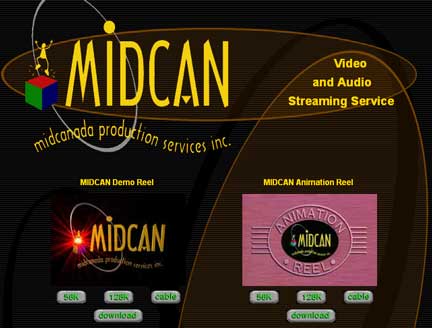

The promise of streaming online video has been with us for some time with the first practical demonstrations in the fall of 96 when Apple's QuickTime technology was reaching a point that would make it eventually possible.
The "iCraveTV" project we talked about here in Ensign back on December 4, 1999 has since then run into some legal problems but its underlying technology is less then acceptable. However, the progress of putting streaming video signals onto the Internet continues and now appears to have reached a viable level.
The main technical facilitator to the process is Apple's QuickTime which is now appearing to be more and more accepted as the most
 practical and upgradable method for accomplishing this rather difficult
process. With the release of QuickTime 4 and its subsequent upgrades the
level of capability has achieved what would be considered as minimal acceptable levels.
practical and upgradable method for accomplishing this rather difficult
process. With the release of QuickTime 4 and its subsequent upgrades the
level of capability has achieved what would be considered as minimal acceptable levels.
Television is now heavily relying upon MPEG compression for direct and cable distribution but this form of compression can not do what QuickTime can do and there is a growth in streaming technology as production companies and advertisers see this as a new means of transporting the message. When you have a look at the samples you will immediately discover that the video quality is dependent upon the speed of change in the image. Something that changes quickly will appear blurry or not appear at all but a talking head will appear clear and detailed. The other feature is the sound.
Surprisingly, unlike "RealVideo" QuickTime streaming is able to move the sound to you as soon as the transmission begins and can keep up moving the information to you continuously. In a practical sense it is necessary to understand how these things are accomplished.
A video is first digitised then processed using "Sorenson" compression. Then the resulting file is placed on a special server with a high speed connection to the Internet. When you connect to this server and request the file it cues up QuickTime and the QuickTime player pops up on your screen (this is the QuickTime player in this picture) the connection takes place and buffering begins as information is sent to you and in less then five seconds the production begins to appear and be heard on your machine.
 Many people will discover it does not work on their
computer but that is only because you have not upgraded your Internet Explorer
or Netscape browser lately. Both of these come with QuickTime installed
and when you click on the streaming video the QuickTime player is turned on
and appears on your screen.
Many people will discover it does not work on their
computer but that is only because you have not upgraded your Internet Explorer
or Netscape browser lately. Both of these come with QuickTime installed
and when you click on the streaming video the QuickTime player is turned on
and appears on your screen.The real beauty of QuickTime streaming is that it will work even with a dial-up telephone line connection as we have in rural Saskatchewan. However, with faster connections like high speed ISDN or a cable modem the image is full screen and appears close to television quality. For us out here we will have to be satisfied with our fuzzy pictures for some time to come.
There are many services like this one at MidCan in Winnipeg springing up were video can be produced and then served on high speed servers on a web page anywhere. This means that a company can do up an advertising video then link to that video from their web site and a visitor can see the video streamed to their computer anytime of the day or night. For advertisers this is heaven because their investment in a commercial can go to a target audience who is choosing to video that message.
If you click on any of the pictures on this page you will find yourself at MidCan's web site where you can look at the video samples and get some idea of how this process might be used. Though it looks like advertisers will be the first to adopt this technology I suspect its use in education, public information and preservation of important and historical events will find the use of streaming video ideal. Unlike television, which is a time related event, streaming video can be sitting there waiting for you the viewer to look at what you want to see and hear.
Andrew Shire, who was one of the founders of Faster Than Light Communications now is with MidCan and was instrumental in creating these samples. The process has not been instantaneous as he began working on this project just over a month ago and MidCan has moved quickly to position itself as the leader in developing this form of media. However, while this commercial project is developing, public sector interest in both government and education are rapidly sorting out the capabilities of streaming video and we can expect to see these agencies as major players in developing and using this new and practical form of communications. The process is not expensive as it does not rely upon expensive equipment to make or serve the material, the cost is in the high speed connection to the Internet necessary to provide the server with the capability of pumping out the information as it is consumed.